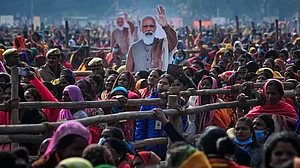India’s women-centric policies were conceived mostly under global influence, until the rising women voter turnout in the country changed the trend.
-
COVER STORY
-
The Modi government had no time to get into the more demanding fundamentals concerning the implementation of the legislation
Indira Gandhi wielded her authority so strongly that she went on to be described as the 'only male' in the ministry full of 'old women', the last description referring to Congress veterans.
Mamata Banerjee stands out in stark contrast—she is neither heir to anyone else’s position nor does she have any wealth to support her political aspirations.
Gandhian institutions and memorials should be insulated from governmental interference and from takeover bids
The support for the Women’s Reservation bill reaffirms India’s faith in affirmative action even as it highlights its dichotomous allegiance to ‘meritocracy’ at the cost of inequity.
Women legislators are perceived as more democratic, people-oriented and inclined towards a collectivist approach as opposed to their male counterparts. Women-led states often scored higher in developmental metrics like roads, healthcare and education.
-
The Modi government had no time to get into the more demanding fundamentals concerning the implementation of the legislation
-
Indira Gandhi wielded her authority so strongly that she went on to be described as the 'only male' in the ministry full of 'old women', the last description referring to Congress veterans.
-
Mamata Banerjee stands out in stark contrast—she is neither heir to anyone else’s position nor does she have any wealth to support her political aspirations.
-
Gandhian institutions and memorials should be insulated from governmental interference and from takeover bids
-
The support for the Women’s Reservation bill reaffirms India’s faith in affirmative action even as it highlights its dichotomous allegiance to ‘meritocracy’ at the cost of inequity.
-
Women legislators are perceived as more democratic, people-oriented and inclined towards a collectivist approach as opposed to their male counterparts. Women-led states often scored higher in developmental metrics like roads, healthcare and education.







